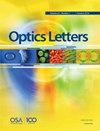CGMRF: CLIP-guide多模态配准与融合的可见-红外双模成像系统。
IF 3.3
2区 物理与天体物理
Q2 OPTICS
引用次数: 0
摘要
在这篇文章中,我们提出了一种基于语义理解的多模态图像融合系统,用于可见光和红外(IR)双模态成像。CGMRF利用语义相似性,更好地与人类视觉解释保持一致,以解决多模态图像配准和融合的挑战。跨多个指标的实验结果证明了所提出的CGMRF系统的优势。本文章由计算机程序翻译,如有差异,请以英文原文为准。
CGMRF: CLIP-guide multimodal registration and fusion for a visible-infrared dual-modality imaging system.
In this Letter, we propose CLIP-guided multimodal registration and fusion (CGMRF), a semantic understanding-based multimodal image fusion system, for visible and infrared (IR) dual-modality imaging. CGMRF leverages semantic similarity, better aligned with human visual interpretation, to address the challenges of multimodal image registration and fusion. Experimental results across multiple metrics demonstrate the advantages of the proposed CGMRF system.
求助全文
通过发布文献求助,成功后即可免费获取论文全文。
去求助
来源期刊

Optics letters
物理-光学
CiteScore
6.60
自引率
8.30%
发文量
2275
审稿时长
1.7 months
期刊介绍:
The Optical Society (OSA) publishes high-quality, peer-reviewed articles in its portfolio of journals, which serve the full breadth of the optics and photonics community.
Optics Letters offers rapid dissemination of new results in all areas of optics with short, original, peer-reviewed communications. Optics Letters covers the latest research in optical science, including optical measurements, optical components and devices, atmospheric optics, biomedical optics, Fourier optics, integrated optics, optical processing, optoelectronics, lasers, nonlinear optics, optical storage and holography, optical coherence, polarization, quantum electronics, ultrafast optical phenomena, photonic crystals, and fiber optics. Criteria used in determining acceptability of contributions include newsworthiness to a substantial part of the optics community and the effect of rapid publication on the research of others. This journal, published twice each month, is where readers look for the latest discoveries in optics.
 求助内容:
求助内容: 应助结果提醒方式:
应助结果提醒方式:


